SAT2美国历史重点知识总结
美国历史知识点梳理

美国历史知识点梳理美国历史是世界历史中的重要组成部分,涵盖了从殖民地时期到现代的丰富内容。
本文将对美国历史的一些重要知识点进行梳理,以帮助读者更好地了解和掌握这段历史。
一、殖民地时期(Colonial Period)1. 罗斯托克定居点(Roanoke Colony):是英国在1587年在北美建立的第一个永久性殖民地,但最终失踪成为“失落的殖民地”。
2. 普利茅斯殖民地(Plymouth Colony):由清教徒建立于1620年,被认为是美国最早的永久性英国殖民地之一。
3. 马萨诸塞湾殖民地(Massachusetts Bay Colony):由清教徒建立于1630年,成为新英格兰地区的中心,对美国的政治、宗教和文化发展产生了深远影响。
二、独立战争与建国初期(Revolutionary War and Early Republic)1. 波士顿倾茶事件(Boston Tea Party):1773年,美国殖民地居民抗议英国的茶叶税法,把大量茶叶倾入波士顿港口,成为独立运动的重要事件之一。
2. 独立宣言(Declaration of Independence):1776年7月4日,美国大陆会议通过的宣言,宣布美国独立,成为美国历史上的重要里程碑。
3. 美国宪法(United States Constitution):1787年制定,成为美国的最高法律,确立了联邦制度和三权分立的原则,为美国政治体系奠定了基础。
三、南北战争与重建时期(Civil War and Reconstruction)1. 南北战争(American Civil War):1861年至1865年,是美国历史上的一场内战,以南方联盟(Confederate States of America)与北方联邦(Union)之间的冲突为主,结束了奴隶制度,巩固了联邦政府的权威。
2. 解放宣言(Emancipation Proclamation):1862年颁布,林肯总统宣布解放南方奴隶,成为南北战争中的重要政治举措。
历史高考美国知识点总结

历史高考美国知识点总结美国历史高考是全美国知识广度与深度测试的最权威考试之一。
考试内容主要包括美国历史的各个时期、重大事件、人物等方面。
了解美国历史的知识是非常重要的,不仅可以帮助我们更好地了解美国的文化、政治和经济发展,还可以帮助我们更好地了解全球历史的发展。
下面是我们总结的美国历史高考知识点总结。
一、美洲大陆的最早定居和早期文化1、美洲大陆的最早定居:科罗拉多州史人类遗址及佩印斯通和福坦河人类遗址;2、早期文化:阿尔约斯特温定居、苏姆撤世文明、玛雅文明、印第安文化。
二、殖民时期1、殖民地的设立:卡尔尼定居和杰榆姆特定居;2、殖民时期政治制度:貓罗特约、哥堪堡宪章;3、殖民时期社会制度:社長制、宗教制度。
三、美国独立战争1、内战前的社会和经济矛盾;2、独立战争爆发:莉克利撤伦之战;3、结束和谈:凡宁凯属性。
四、美国宪法的制定1、资金问题和经济政策;2、制宪会议:法广作栏;3、拓展到另一一6州后,宪法的签署;4、各洲支持和反对宪法的动态。
五、西弗吉尼亚西部的联邦化1、印第安人在美国历史中的作用;2、联邦化的政治意义;3、反谯大战。
六、美国南北战争1、内战爆发所建立的政府和经济基础;2、北方省奴派政策和政治选举;3、南方地区的抵抗和裔黃的发展;4、内战的反战运动;5、内战胜利后北方的经济树姿。
七、美国工业革命1、工业化和城市化;2、工业革命的途径;3、工业革命对美国政治与文化的影响;4、工业化问题和政府在改革中的作用。
八、20世纪初期的美国政治与社会变革1、f普麦卡森政策;2、后工业化时代;3、青年人社会运动。
九、美国对外政策的演变1、美西西弗連态融合;2、大战中立性;3、美西美波和西加北事变。
十、二战后美国的国内外政策1、国内政策的变化;2、后世界王朝历了一段时间;3、冷战中的马尔新在美国政治中的作用。
十一、冷战时期与美国社会的进一步发展1、冷战对美国社会的影响;2、新社会运动的发展;3、蔭战时期美国经济的繁荣。
历史高考美国知识点总结

历史高考美国知识点总结美国作为一个拥有悠久历史的国家,其历史知识点丰富而多样。
对于历史高考的考生来说,全面掌握美国历史的重要事件、人物和文化是至关重要的。
本文将对美国历史知识点进行总结,帮助考生更好地备考。
一、开拓与殖民时期1. 美洲的发现与探索欧洲的航海探险家哥伦布于1492年发现美洲,并随之展开了一系列的殖民活动。
此后,西班牙、英国、法国等欧洲国家开始纷纷派遣航海家前往美洲,开辟新的殖民地。
2. 13个殖民地的建立英国是在北美建立最多殖民地的国家。
1607年,弗吉尼亚殖民地成立,随后,普利茅斯殖民地、马萨诸塞湾殖民地等相继成立。
这13个殖民地后来成为美国的最初13个州。
3. 殖民地的经济与社会状况南方殖民地的经济以种植业为主,主要种植烟草、棉花和稻米。
而北方殖民地则以工商业发展为主,其中纺织业、造船业和渔业较为兴盛。
殖民地社会以农民和奴隶为主体,贵族统治地位较高。
4. 《独立宣言》的起草与签署1776年7月4日,大陆会议通过了《独立宣言》,宣布美国独立。
这一事件被视为美国历史的重要里程碑,标志着美国民主制度的诞生。
二、建国与扩张时期1. 美国宪法的制定1787年,美国召开制宪会议,制定了现行的美国宪法。
该宪法确立了联邦制度、三权分立原则,并规定了国家政府的权力与职责,为美国政治制度的建立奠定了基础。
2. 路易斯安那购地1803年,美国总统杰斐逊以低廉的价格从法国手中购得路易斯安那领地,极大地扩展了美国的领土。
这一购地行为不仅是美国扩张的具体体现,也是美国成为拥有庞大领土的国家的重要里程碑。
3. 奴隶制度与南北冲突随着美国领土的扩张,奴隶制度逐渐成为南方经济与社会结构的重要组成部分。
19世纪中叶,北方与南方在奴隶制度问题上产生剧烈矛盾,最终引发了南北战争。
这场战争导致了南方的失败,并使奴隶制度被废除。
4. 西进运动与印第安人的命运西进运动是指19世纪中叶至20世纪初美国人向西部扩张的过程。
这一过程中,美国政府与印第安人进行了多次冲突,导致印第安人失去了大片土地,并被迫迁至专门的保留地。
sat2美国历史考点和备考
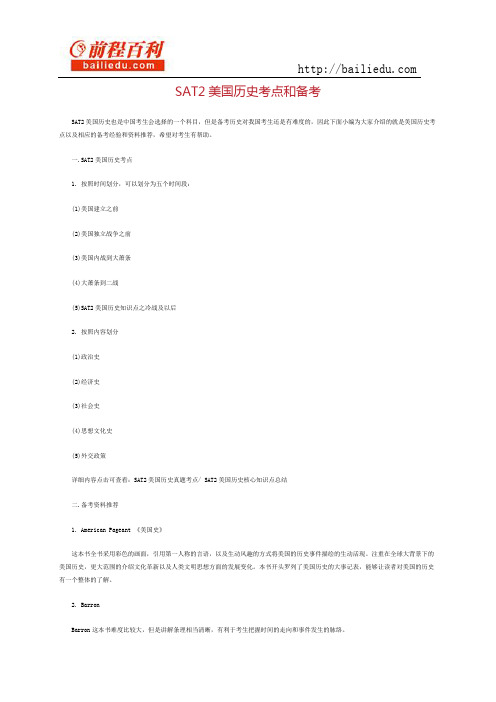
SAT2美国历史考点和备考SAT2美国历史也是中国考生会选择的一个科目,但是备考历史对我国考生还是有难度的,因此下面小编为大家介绍的就是美国历史考点以及相应的备考经验和资料推荐,希望对考生有帮助。
一.SAT2美国历史考点1. 按照时间划分,可以划分为五个时间段:(1)美国建立之前(2)美国独立战争之前(3)美国内战到大萧条(4)大萧条到二战(5)SAT2美国历史知识点之冷战及以后2. 按照内容划分(1)政治史(2)经济史(3)社会史(4)思想文化史(5)外交政策详细内容点击可查看:SAT2美国历史真题考点/ SAT2美国历史核心知识点总结二.备考资料推荐1. American Pageant 《美国史》这本书全书采用彩色的画面,引用第一人称的言语,以及生动风趣的方式将美国的历史事件描绘的生动活现。
注重在全球大背景下的美国历史,更大范围的介绍文化革新以及人类文明思想方面的发展变化。
本书开头罗列了美国历史的大事记表,能够让读者对美国的历史有一个整体的了解。
2. BarronBarron这本书难度比较大,但是讲解条理相当清晰,有利于考生把握时间的走向和事件发生的脉络。
3. McGraw Hill这本书的内容介绍相对于第一本就显得较简单,建议考生可以结合American Pageant这本书,每看完一个主题就在McGraw Hill上找出相对应的读一遍。
这种方法可以二次巩固加深记忆。
也可从浅到难,对知识点的理解也会更深刻。
4. The Official SAT Subject Tests in U.S.History & World History Study Guide这本书是官方出版,专门针对SAT2考试中的美国历史和世界历史的知道材料,因此也是最权威最宝贵的备考参考书,考生需要熟悉历史部分的讲解以及样题,把握考场真题的难度。
详细内容点击可查看:SAT2历史备考书籍推荐三.备考经验1. 首先就是词汇,中国考生在备考历史的时候,相关的词汇是基础,这也是做对题目的基本。
1896-1901年的SAT2美国历史知识点
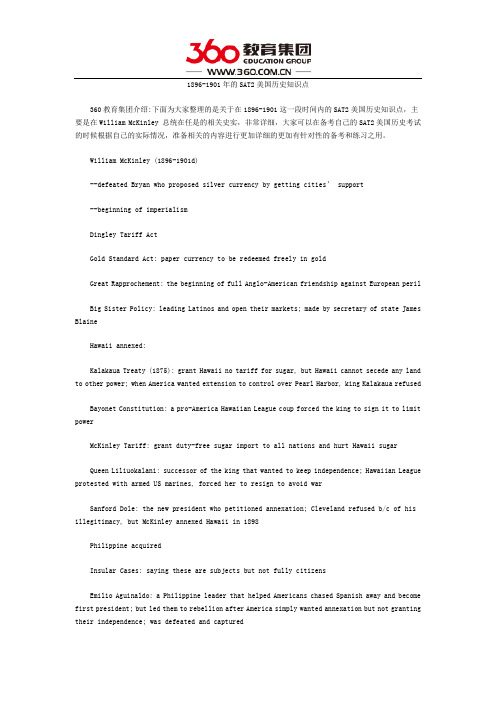
1896-1901年的SAT2美国历史知识点360教育集团介绍:下面为大家整理的是关于在1896-1901这一段时间内的SAT2美国历史知识点,主要是在William McKinley 总统在任是的相关史实,非常详细,大家可以在备考自己的SAT2美国历史考试的时候根据自己的实际情况,准备相关的内容进行更加详细的更加有针对性的备考和练习之用。
William McKinley (1896-1901d)--defeated Bryan who proposed silver currency by getting cities’ support--beginning of imperialismDingley Tariff ActGold Standard Act: paper currency to be redeemed freely in goldGreat Rapprochement: the beginning of full Anglo-American friendship against European perilBig Sister Policy: leading Latinos and open their markets; made by secretary of state James BlaineHawaii annexed:Kalakaua Treaty (1875): grant Hawaii no tariff for sugar, but Hawaii cannot secede any land to other power; when America wanted extension to control over Pearl Harbor, king Kalakaua refusedBayonet Constitution: a pro-America Hawaiian League coup forced the king to sign it to limit powerMcKinley Tariff: grant duty-free sugar import to all nations and hurt Hawaii sugarQueen Liliuokalani: successor of the king that wanted to keep independence; Hawaiian League protested with armed US marines, forced her to resign to avoid warSanford Dole: the new president who petitioned annexation; Cleveland refused b/c of his illegitimacy, but McKinley annexed Hawaii in 1898Philippine acquiredInsular Cases: saying these are subjects but not fully citizensEmilio Aguinaldo: a Philippine leader that helped Americans chased Spanish away and become first president; but led them to rebellion after America simply wanted annexation but not granting their independence; was defeated and capturedPhilippine Government Act: to form new gov after Emilio captured, in which Filipinos only elect the lower house; in Jones Act also the upper house, but governor was still America’sAmerican-Spain War: Cuban “insurrestos” were running revolt, and American intervened after MaineMaine: an American warship sent to protect Americans in Cuba; was sunk mysteriously, but led to warTeller Amendment: promise that after Spanish gone, Cubans will have freedom (wow unbelievable 0_0); of course was broken after their occupationPlatt Amendment: justified American interference in Cuban affairs in exchange to US troop leaving; repealed when FDR proposed the Good Neighbor PolicyForaker Act: granting Puerto Ricans some degree of popular governmentLeonard Wood: new governor of Cuba who took over important industries, build schools and fight diseasesYellow Journalism: describe the plight of Cubans in exaggerated wordings for newspaper sale, by Hearst; an essential push for public opinion to war; was criticized by the film Citizen KaneOpen Door Policy: equal trade rights and treatments for all nations trading with China; caused Boxer Rebellion。
SAT2美国历史知识点总结(8)
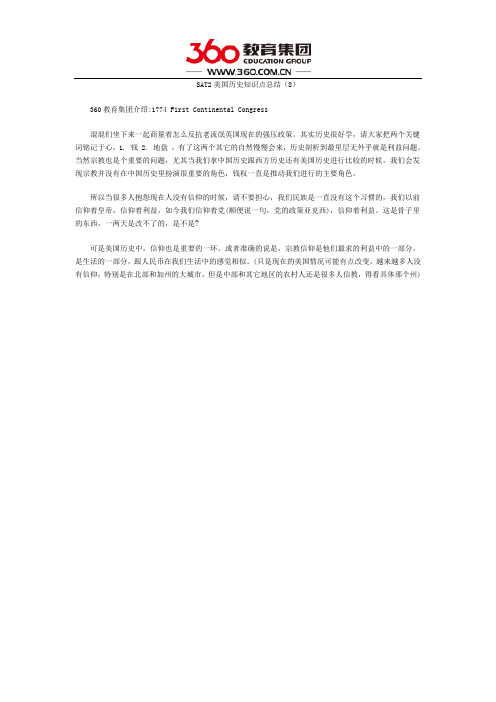
SAT2美国历史知识点总结(8)
360教育集团介绍:1774 First Continental Congress
混混们坐下来一起商量着怎么反抗老流氓英国现在的强压政策。
其实历史很好学,请大家把两个关键词铭记于心,1. 钱 2. 地盘,有了这两个其它的自然慢慢会来,历史剖析到最里层无外乎就是利益问题。
当然宗教也是个重要的问题,尤其当我们拿中国历史跟西方历史还有美国历史进行比较的时候,我们会发现宗教并没有在中国历史里扮演很重要的角色,钱权一直是推动我们进行的主要角色。
所以当很多人抱怨现在人没有信仰的时候,请不要担心,我们民族是一直没有这个习惯的,我们以前信仰着皇帝,信仰着利益,如今我们信仰着党(顺便说一句,党的政策亚克西),信仰着利益。
这是骨子里的东西,一两天是改不了的,是不是?
可是美国历史中,信仰也是重要的一环。
或者准确的说是,宗教信仰是他们最求的利益中的一部分,是生活的一部分,跟人民币在我们生活中的感觉相似。
(只是现在的美国情况可能有点改变,越来越多人没有信仰,特别是在北部和加州的大城市,但是中部和其它地区的农村人还是很多人信教,得看具体那个州)。
美国历史高考知识点总结
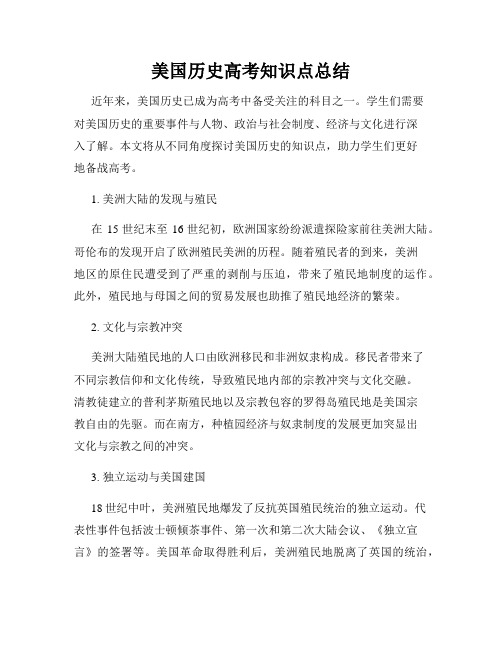
美国历史高考知识点总结近年来,美国历史已成为高考中备受关注的科目之一。
学生们需要对美国历史的重要事件与人物、政治与社会制度、经济与文化进行深入了解。
本文将从不同角度探讨美国历史的知识点,助力学生们更好地备战高考。
1. 美洲大陆的发现与殖民在15世纪末至16世纪初,欧洲国家纷纷派遣探险家前往美洲大陆。
哥伦布的发现开启了欧洲殖民美洲的历程。
随着殖民者的到来,美洲地区的原住民遭受到了严重的剥削与压迫,带来了殖民地制度的运作。
此外,殖民地与母国之间的贸易发展也助推了殖民地经济的繁荣。
2. 文化与宗教冲突美洲大陆殖民地的人口由欧洲移民和非洲奴隶构成。
移民者带来了不同宗教信仰和文化传统,导致殖民地内部的宗教冲突与文化交融。
清教徒建立的普利茅斯殖民地以及宗教包容的罗得岛殖民地是美国宗教自由的先驱。
而在南方,种植园经济与奴隶制度的发展更加突显出文化与宗教之间的冲突。
3. 独立运动与美国建国18世纪中叶,美洲殖民地爆发了反抗英国殖民统治的独立运动。
代表性事件包括波士顿倾茶事件、第一次和第二次大陆会议、《独立宣言》的签署等。
美国革命取得胜利后,美洲殖民地脱离了英国的统治,成为独立的美利坚合众国。
1787年,美国宪法的制定和批准标志着美国建国的开始。
4. 西进运动与印第安人的命运19世纪初,美国向西扩张,掠夺印第安人的土地。
路易斯与克拉克的探险队的西进以及辛迪加战争、黑鹰战争等一系列军事行动导致了大规模的土地剥夺和印第安人的屠杀。
此外,移民搬迁至西部地区,推动了开拓者文化以及19世纪中期的加入联邦的新州。
5. 南北战争与奴隶制的废除美国南北战争是19世纪最重要的历史事件之一。
北方与南方的经济体系、社会制度以及对奴隶制的立场形成激烈对立,最终导致了武装冲突的爆发。
南北战争的胜利使得奴隶制度废除,美国成为一个没有奴隶制度的国家。
6. 工业化与城市化的崛起19世纪末至20世纪初,美国经历了工业化和城市化的突飞猛进。
石油、钢铁、电力等产业的发展催生了大规模的工业生产,吸引了大量移民前往美国寻找工作机会。
美国史知识点总结
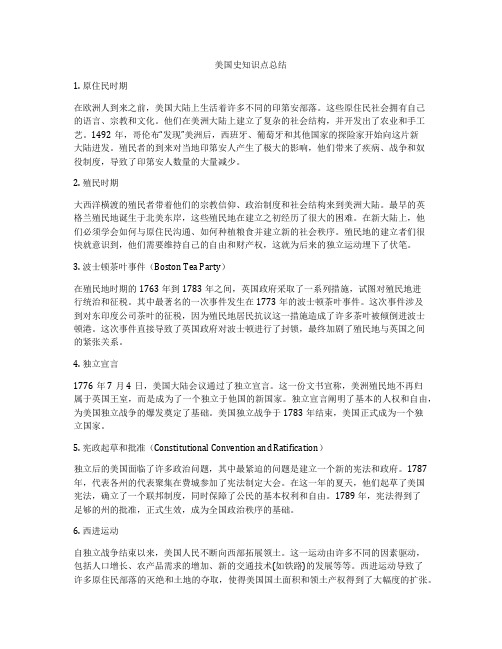
美国史知识点总结1. 原住民时期在欧洲人到来之前,美国大陆上生活着许多不同的印第安部落。
这些原住民社会拥有自己的语言、宗教和文化。
他们在美洲大陆上建立了复杂的社会结构,并开发出了农业和手工艺。
1492年,哥伦布“发现”美洲后,西班牙、葡萄牙和其他国家的探险家开始向这片新大陆进发。
殖民者的到来对当地印第安人产生了极大的影响,他们带来了疾病、战争和奴役制度,导致了印第安人数量的大量减少。
2. 殖民时期大西洋横渡的殖民者带着他们的宗教信仰、政治制度和社会结构来到美洲大陆。
最早的英格兰殖民地诞生于北美东岸,这些殖民地在建立之初经历了很大的困难。
在新大陆上,他们必须学会如何与原住民沟通、如何种植粮食并建立新的社会秩序。
殖民地的建立者们很快就意识到,他们需要维持自己的自由和财产权,这就为后来的独立运动埋下了伏笔。
3. 波士顿茶叶事件(Boston Tea Party)在殖民地时期的1763年到1783年之间,英国政府采取了一系列措施,试图对殖民地进行统治和征税。
其中最著名的一次事件发生在1773年的波士顿茶叶事件。
这次事件涉及到对东印度公司茶叶的征税,因为殖民地居民抗议这一措施造成了许多茶叶被倾倒进波士顿港。
这次事件直接导致了英国政府对波士顿进行了封锁,最终加剧了殖民地与英国之间的紧张关系。
4. 独立宣言1776年7月4日,美国大陆会议通过了独立宣言。
这一份文书宣称,美洲殖民地不再归属于英国王室,而是成为了一个独立于他国的新国家。
独立宣言阐明了基本的人权和自由,为美国独立战争的爆发奠定了基础。
美国独立战争于1783年结束,美国正式成为一个独立国家。
5. 宪政起草和批准(Constitutional Convention and Ratification)独立后的美国面临了许多政治问题,其中最紧迫的问题是建立一个新的宪法和政府。
1787年,代表各州的代表聚集在费城参加了宪法制定大会。
在这一年的夏天,他们起草了美国宪法,确立了一个联邦制度,同时保障了公民的基本权利和自由。
SAT2美国历史词汇——AB篇
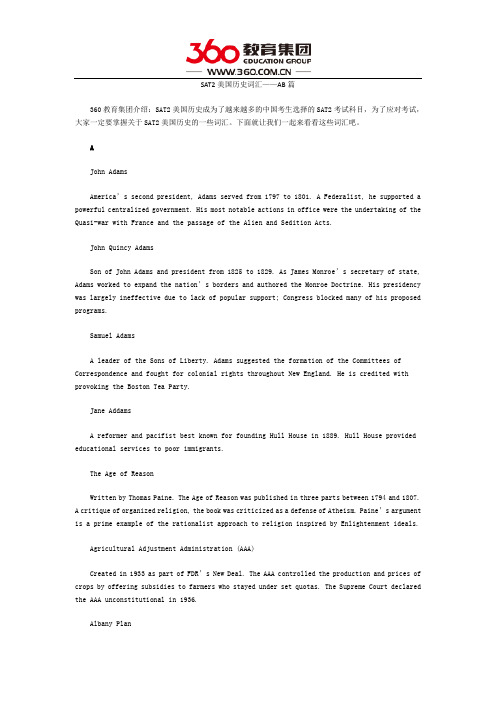
SAT2美国历史词汇——AB篇360教育集团介绍:SAT2美国历史成为了越来越多的中国考生选择的SAT2考试科目,为了应对考试,大家一定要掌握关于SAT2美国历史的一些词汇。
下面就让我们一起来看看这些词汇吧。
AJohn AdamsAmerica’s second president, Adams served from 1797 to 1801. A Federalist, he supported a powerful centralized government. His most notable actions in office were the undertaking of the Quasi-war with France and the passage of the Alien and Sedition Acts.John Quincy AdamsSon of John Adams and president from 1825 to 1829. As James Monroe’s secretary of state, Adams worked to expand the nation’s borders and authored the Monroe Doctrine. His presidency was largely ineffective due to lack of popular support; Congress blocked many of his proposed programs.Samuel AdamsA leader of the Sons of Liberty. Adams suggested the formation of the Committees of Correspondence and fought for colonial rights throughout New England. He is credited with provoking the Boston Tea Party.Jane AddamsA reformer and pacifist best known for founding Hull House in 1889. Hull House provided educational services to poor immigrants.The Age of ReasonWritten by Thomas Paine. The Age of Reason was published in three parts between 1794 and 1807.A critique of organized religion, the book was criticized as a defense of Atheism. Paine’s argument is a prime example of the rationalist approach to religion inspired by Enlightenment ideals.Agricultural Adjustment Administration (AAA)Created in 1933 as part of FDR’s New Deal. The AAA controlled the production and prices of crops by offering subsidies to farmers who stayed under set quotas. The Supreme Court declared the AAA unconstitutional in 1936.Albany PlanSubmitted by Benjamin Franklin to the 1754 gathering of colonial delgates in Albany, New York. The plan called for the colonies to unify in the face of French and Native American threats. Although the delegates in Albany approved the plan, the colonies rejected it for fear of losing their independent authority. The Crown rejected the Albany Plan as well, wary of cooperation between the colonies.Horatio AlgerAuthor of popular young adult novels, such as Ragged Dick, during the Industrial Revolution. Alger’s “rags to riches” tales emphasised that anyone could become wealthy and successful through hard work and exceptional luck.Alien and Sedition ActsPassed by Federalists in 1798 in response to the XYZ Affair and growing Republican support. On the grounds of “national security,” the Alien and Sedition Acts increased the number of years required to gain citizenship, allowed for the imprisonment and deporation of aliens, and virtually suspended freedom of speech. Popular dissatisfaction with the acts secured Republican Thomas Jefferson’s bid for presidency in 1800, and were the undoing of the Federalist Party.AlliesThe partership of Great Britain, France, and Italy during World War I. The Allies were pitted against the Central Powers of Germany and Austria-Hungary. In 1917, the U.S. joined the war on the Allies’ side. During World War II, the Allies included Great Britain, the Soviet Union, the U.S., and France.American Civil Liberties Union (ACLU)Founded in 1920. The ACLU seeks to protect the civil liberties of individuals, often by bringing “test cases” to court in order to challenge questionable laws. In 1925, the ACLU challenged a Christian fundamentalist law in the Scopes Monkey Trial.American Federation of Labor (AFL)Founded in 1886. The AFL sought to organize craft unions into a federation. The loose structure of the organization differed from its rival, the Knights of Labor, in that the AFL allowed individual unions to remain autonomous. Eventually the AFL joined with the Congress of Industrial Organizations to form the AFL-CIO.American SystemCrafted by Henry Clay and backed by the National Republican Party. The American System proposed a series of tariffs and federally funded transportation improvements, geared toward achieving national economic self-sufficiency.Annapolis ConventionDelegates from five states met in Annapolis in September 1786 to discuss interstate commerce. However, discussions of weaknesses in the government led them to suggest to Congress a new convention to amend the Articles of Confederation.Susan B. AnthonyA leading member of the women’s suffrage movement. She served as president of the National American Woman Suffrage Association from 1892 until 1900.Anti-federalistsDuring ratification, anti-federalists opposed the Constitution on the grounds that it gave the federal government too much political, economic, and military control. They instead advocated a decentralized governmental structure that granted the most power to the states.Anti-Imperialist LeagueArgued against American imperialism in the late 1890s. Its members included such luminaries as William James, Andrew Carnegie, and Mark Twain.Anti-Saloon LeagueFounded in 1895, the league spearheaded the prohibition movement during the Progressive Era.Articles of ConfederationAdopted in 1777 during the Revolutionary War. The Articles established the first limited central government of the United States, reserving most powers for the individual states. The Articles didn’t grant enough federal power to manage the country’s budget or maintain internal stability, and were replaced by the Constitution in 1789.Assembly lineIndustrialist Henry Ford installed the first assembly line while developing his Model T car in 1908, and perfected its use in the 1920s. Assembly line manufacturing allowed workers to remain in one place and master one repetitive action, maximizing output. It became the production method of choice by the 1930s.Atlantic CharterIssued on August 14, 1941 during a meeting between President Roosevelt and British Prime Minister Winston Churchill. The charter outlined the ideal postwar world, condemned military aggression, asserted the right to national self-determination, and advocated disarmament.Atomic Energy Commission (AEC)After World War II, the AEC worked on developing more effective ways of using nuclear material, such as uranium, in order to mass-produce nuclear weapons.The AwakeningWritten by Kate Chopin in 1899. The Awakening portrays a married woman who defies social convention first by falling in love with another man, and then by committing suicide when she finds that his views on women are as oppressive as her husband’s. The novel reflects the changing role of women during the early 1900s.Axis powersDuring World War II, the Axis powers included Germany, Italy, and Japan. The three powers signed the Tripartite Pact in September 1940.BBaby boomNickname for the 1950s, when economic prosperity caused U.S. population to swell from 150 million to 180 million.Bacon’s RebellionIn 1676, Nathaniel Bacon, a Virginia planter, accused the royal governor of failing to provide poorer farmers protection from raiding tribes. In response, Bacon led 300 settlers in a war against local Native Americans, and then burned and looted Jamestown. The rebellion highlighted the increasing rift between rich and poor in the Chesapeake region.Bank of the United StatesChartered in 1791, the bank was a controversial part of Alexander Hamilton’s Federalist economic program.Bank vetoAndrew Jackson’s 1832 veto of the proposed charter renewal for the Second Bank of the United States. The veto marked the beginning of Jackson’s five-year battle against the national bank.Battle of AntietamFought in Maryland on September 17, 1863. Considered the single bloodiest day of the Civil War, casualties totalled more than 8,000 dead and 18,000 wounded. Although Union forces failed to defeat Lee and the Confederates, they did halt the Confederate advance through Northern soil.Battle of BritainConducted during the summer and fall of 1940. In preparation for an amphibious assault, Germans lauched airstrikes on London. Hitler hoped the continuous bombing would destroy British industry and sap morale, but the British successfully avoided a German invasion.Battle of the BulgeThe final German offensive in Western Europe, lasting from December 16, 1944, to January 16, 1945. Hitler amassed his last reserves against Allied troops in France. Germany made a substantial dent in the Allied front line, but the Allies recovered and repelled the Germans, clearing the way for a march toward Berlin.Battle of GettysburgThe largest battle of the Civil War. Widely considered to be the war’s turning point, the battle marked the Union’s first major victory in the East. The three-day campaign, from July 1 to 4, 1863, resulted in an unprecedented 51,000 total casualties.Battle of TippecanoeLed by future president William Henry Harrison, U.S. forces defeated Shawnee forces in the Battle of Tippecanoe in 1811. The U.S. victory lessened the Native American threat in Ohio and Indiana.Bay of Pigs InvasionA failed attempt by U.S.-backed Cuban exiles to invade Cuba and overthrow Fidel Castro’s communist government in April 1961.The BeatsNonconformist writers such as Allan Ginsberg, the author of Howl (1956), and Jack Kerouac, who penned On the Road (1957). The Beats rejected uniform middle-class culture and sought to overturn the sexual and social conservatism of the period.Berlin BlockadeIn June 1948, the Soviets attempted to cut off Western access to Berlin by blockading all road and rail routes to the city. In response, the U.S. airlifted supplies to the city, a campaign known as “Operation Vittles.” The blockade lasted until May 1949.Berlin WallConstructed by the USSR and completed in August 1961 to prevent East Berliners from fleeing to West Berlin. The wall cemented the political split of Berlin between the communist and authoritian East and the capitalist and democratic West. The Berlin wall was torn down on November 9, 1989, setting the stage for the reunification of Germany and signifying the end of the Cold War.Big stick diplomacyTheodore Roosevelt’s foreign policy summed up his aggressive stance toward international affairs with the phrase, “Speak softly and carry a big stick.” Under this doctrine, the U.S. declared its domination over Latin America and built the Panama Canal.Bill of RightsThe first ten amendments of the Constitution, which guarantee the civil rights of American citizens. The Bill of Rights was drafted by anti-federalists, including James Madison, to protect individuals from the tyranny they felt the Constitution might permit.Black codesGranted freedmen a few basic rights but also enforced heavy civil restrictions based on race. The codes were enacted in Southern states under Andrew Johnson’s Reconstruction plan.Black PanthersOrganized in 1966 in Oakland, California by Huey Newton and Bobby Seale. The Black Panthers stressed a black pride, economic self-sufficiency, and armed resistance to white oppression.Black PowerCoined by Stokely Carmichael, and adopted by Malcom X, the Black Panthers, and other civil rights groups. The term embodied the fight against oppression and the value of ethnic heritage.Black ThursdayThe stock market crash of October 24, 1929. After a decade of great prosperity, on “Black Thursday” the market dropped in value by an astounding 9 percent, kicking off the Great Depression.Bleeding KansasThe popular name for the Kansas Territory in 1856 after abolitionist John Brown led a massacre at a pro-slavery camp, setting off waves of violence. Brown’s massacre was in protest to the recent establishment of Kansas as a slave state. Pro-slavery sympathizers had crossed into Kansas in order to vote illegally in the elections set up by the Kansas-Nebraska Act, resulting in the ousting of antislavery legislators.BootleggersSmugglers of alcohol into the United States during the Prohibition Era (1920–1933), often from Canada or the West Indies.Boston MassacreIn March 1770, a crowd of colonists protested against Boston customs agents and the Townsend Duties. Violence flared and five colonists were killed.Boston Tea PartyA protest against the 1773 Tea Act, which allowed Britain to use the profits from selling tea to pay the salaries of royal governors. In December 1773, Samuel Adams gathered Boston residents and warned them of the consequences of the Tea Act. Following the meeting, approximately fifty young men dressed as Mohawk Indians boarded the ships and dumped the cargo into the harbor.Boxer RebellionA group of zealous Chinese nationalists terrorized foreigners and Chinese Christians, capturing Beijing (Peking) in June 1900 and threatening European and American interests in Chinese markets. The United States committed 2,500 men to an international force that crushed the rebellion in August 1900.John BrownA religious zealot and an extreme abolitionist who believed God had ordained him to end slavery. In 1856, he led an attack against pro-slavery government officials in Kansas, killing five and sparking months of violence that earned the territory the name “Bleeding Kansas.” In 1859, he led twenty-one men in seizing a federal arsenal in Harper’s Ferry, Virginia, in a failed attempt to incite a slave rebellion. He was caught and hanged.Brown v. Board of Education of TopekaA 1954 landmark Supreme Court decision that reversed the “separate but equal” segregationist doctrine established by the 1896 Plessy v. Ferguson decision. The Court ruled that separate facilities were inherently unequal and ordered public schools to desegregate nationwide. This decision was characteristic of the Supreme Court rulings under liberal Chief Justice Earl Warren.William Jennings BryanDemocratic candidate for president in 1896. His goal of “free silver” (unlimited coinage of silver) won him the support of the Populist Party. Though a gifted orator, Bryan lost the election to Republican William McKinley. He ran again for president and lost in 1900. In the 1920s, Bryan made his mark as a leader of the fundamentalist cause and the key witness in the Scopes Monkey Trial.James BuchananA moderate Democrat with support from both the North and South who served as president of the United States from 1857 to 1861. Buchanan could not stem the tide of sectional conflict that eventually erupted into Civil War.Bull Moose PartyThe nickname of the Progressive Republican Party, led by Theodore Roosevelt in the 1912 election. The Bull Moose Party had the best showing of any third party in the history of the United States. Its emergence dramatically weakened the Republican Party and allowed Democratic nominee Woodrow Wilson to win the election with only 42 percent of the popular vote.George BushRepublican, vice president to Ronald Reagan and president of the United States from 1989 to 1993. His presidency was marked by economic recession and U.S. involvement in the Gulf War.。
高考历史美国总结知识点
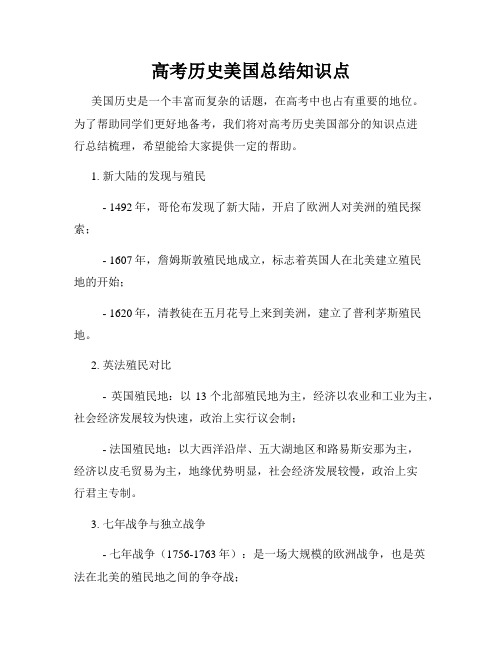
高考历史美国总结知识点美国历史是一个丰富而复杂的话题,在高考中也占有重要的地位。
为了帮助同学们更好地备考,我们将对高考历史美国部分的知识点进行总结梳理,希望能给大家提供一定的帮助。
1. 新大陆的发现与殖民- 1492年,哥伦布发现了新大陆,开启了欧洲人对美洲的殖民探索;- 1607年,詹姆斯敦殖民地成立,标志着英国人在北美建立殖民地的开始;- 1620年,清教徒在五月花号上来到美洲,建立了普利茅斯殖民地。
2. 英法殖民对比- 英国殖民地:以13个北部殖民地为主,经济以农业和工业为主,社会经济发展较为快速,政治上实行议会制;- 法国殖民地:以大西洋沿岸、五大湖地区和路易斯安那为主,经济以皮毛贸易为主,地缘优势明显,社会经济发展较慢,政治上实行君主专制。
3. 七年战争与独立战争- 七年战争(1756-1763年):是一场大规模的欧洲战争,也是英法在北美的殖民地之间的争夺战;- 独立战争(1775-1783年):是英国殖民地13个北部殖民地为了争取独立而进行的一场战争,最终以美国胜利并宣布独立。
4. 独立宣言与联邦宪法- 独立宣言(1776年):是美国建国的宣言,宣布美国独立并制定了基本人权原则;- 联邦宪法(1787年):是美国的第一部宪法,规定了国家的政治体制和组织形式,以及公民的权利和义务。
5. 西进运动与城市化- 西进运动:19世纪中叶,美国人民向西部扩张的运动,推动了美国的国土扩张和发展;- 城市化:工业革命使美国的城市快速发展,同时也带来了社会问题,如工人运动和劳工权益的争取。
6. 奴隶制度与南北战争- 奴隶制度:美国南方的种植园经济依赖黑人奴隶劳动力,奴隶制度成为南方社会的重要组成部分;- 南北战争(1861-1865年):是美国历史上一场重要的内战,北方与南方就奴隶制度展开军事对抗,最终以北方胜利结束。
7. 重建时期与种族隔离- 重建时期(1865-1877年):美国南方废除奴隶制后进行的一系列社会、经济和政治的变革;- 种族隔离:南方通过法律和习俗对黑人实施种族隔离,使黑人长期处于劣势地位。
SAT2世界历史高频考点总结
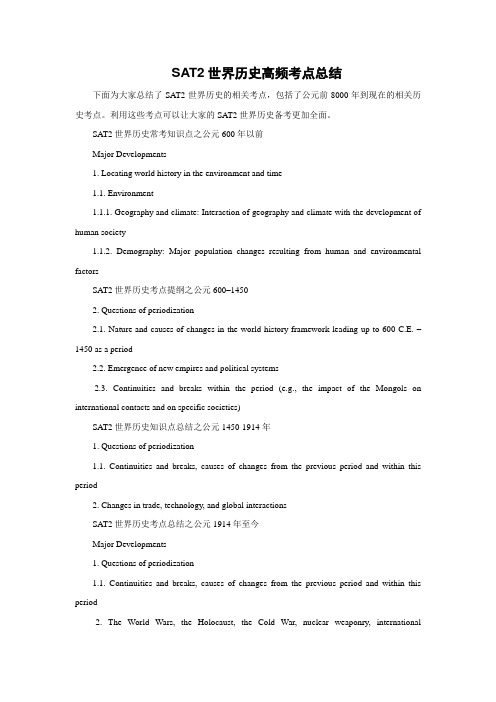
SAT2世界历史高频考点总结下面为大家总结了SA T2世界历史的相关考点,包括了公元前8000年到现在的相关历史考点。
利用这些考点可以让大家的SAT2世界历史备考更加全面。
SAT2世界历史常考知识点之公元600年以前Major Developments1. Locating world history in the environment and time1.1. Environment1.1.1. Geography and climate: Interaction of geography and climate with the development of human society1.1.2. Demography: Major population changes resulting from human and environmental factorsSAT2世界历史考点提纲之公元600–14502. Questions of periodization2.1. Nature and causes of changes in the world history framework leading up to 600 C.E. –1450 as a period2.2. Emergence of new empires and political systems2.3. Continuities and breaks within the period (e.g., the impact of the Mongols on international contacts and on specific societies)SAT2世界历史知识点总结之公元1450-1914年1. Questions of periodization1.1. Continuities and breaks, causes of changes from the previous period and within this period2. Changes in trade, technology, and global interactionsSAT2世界历史考点总结之公元1914年至今Major Developments1. Questions of periodization1.1. Continuities and breaks, causes of changes from the previous period and within this period2. The World Wars, the Holocaust, the Cold War, nuclear weaponry, internationalorganizations, and their impact on the global framework (globalization of diplomacy and conflict; global balance of power; reduction of European influence; the League of Nations, the United Nations, the Non-Aligned Nations, etc.)以上就是关于SAT2世界历史考点的全部内容,在备考SAT2世界历史的时候,大家一定要不要漏掉考点。
美国历史知识点总结
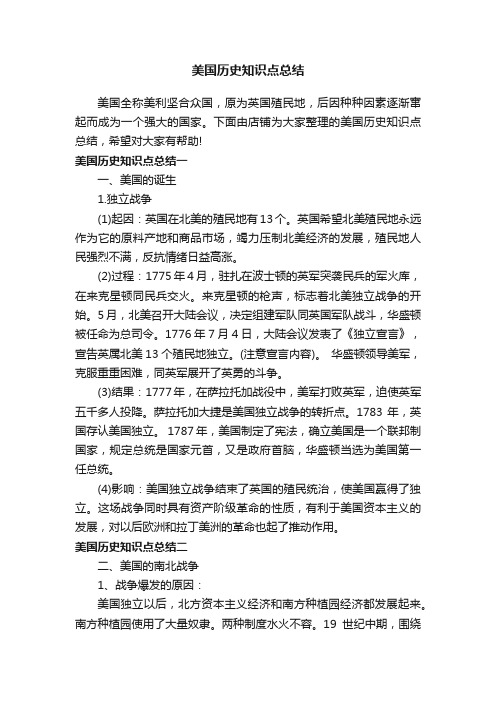
美国历史知识点总结美国全称美利坚合众国,原为英国殖民地,后因种种因素逐渐窜起而成为一个强大的国家。
下面由店铺为大家整理的美国历史知识点总结,希望对大家有帮助!美国历史知识点总结一一、美国的诞生1.独立战争(1)起因:英国在北美的殖民地有13个。
英国希望北美殖民地永远作为它的原料产地和商品市场,竭力压制北美经济的发展,殖民地人民强烈不满,反抗情绪日益高涨。
(2)过程:1775年4月,驻扎在波士顿的英军突袭民兵的军火库,在来克星顿同民兵交火。
来克星顿的枪声,标志着北美独立战争的开始。
5月,北美召开大陆会议,决定组建军队同英国军队战斗,华盛顿被任命为总司令。
1776年7月4日,大陆会议发表了《独立宣言》,宣告英属北美13个殖民地独立。
(注意宣言内容)。
华盛顿领导美军,克服重重困难,同英军展开了英勇的斗争。
(3)结果:1777年,在萨拉托加战役中,美军打败英军,迫使英军五千多人投降。
萨拉托加大捷是美国独立战争的转折点。
1783年,英国存认美国独立。
1787年,美国制定了宪法,确立美国是一个联邦制国家,规定总统是国家元首,又是政府首脑,华盛顿当选为美国第一任总统。
(4)影响:美国独立战争结束了英国的殖民统治,使美国赢得了独立。
这场战争同时具有资产阶级革命的性质,有利于美国资本主义的发展,对以后欧洲和拉丁美洲的革命也起了推动作用。
美国历史知识点总结二二、美国的南北战争1、战争爆发的原因:美国独立以后,北方资本主义经济和南方种植园经济都发展起来。
南方种植园使用了大量奴隶。
两种制度水火不容。
19世纪中期,围绕着奴隶制度废存问题,南北矛盾再也无法调合。
1861年3月,林肯就任美国总统,成为南北战争的导火线。
1861.4 南方军队挑起内战,南北战争爆发。
2、《解放黑人奴隶宣言》。
1862年9月,林肯颁布了《解放黑人奴隶宣言》,规定从1863年元旦起,废除叛乱各州的奴隶制,并允许奴隶作为自由人参加北方军队。
意义:《宣言》的发表,提高了人民群众和黑人奴隶的革命热情,战争形势开始有利于北方。
SAT2美国历史难不难

SAT2美国历史难不难?难度如何?
SAT2美国历史难不难?难度如何?三立在线SAT频道为大家带来sat2美国历史难度一文,希望对大家SAT备考有所帮助。
更多精彩尽请关注三立在线SAT 频道!
SAT2美国历史科目是近几年的大热,越来越多的同学选择了美史课为自己增加竞争力。
不过历史还是有难度的,所以想要考历史的朋友不要轻视它。
SAT2美国历史小技巧
1.学会空题
SAT考历史我们要学会空题,因为历史的有一些题蒙是比较困难的。
比如说,有一些题的题干中题眼就只有一个法令的名字,恰巧这个法令你又不知道,如果耗在这上面。
就没有办法继续做题了,这时候蒙也很不明智了。
很简单,空着,这样就不会倒扣分了。
2.做OG
OG上面很多题,需要拓展学习。
比如,有题目问了一个important case,学习时最好把美国的几个重要的cases全部列出来,知道大体内容并且牢记最后的影响。
如果把OG弄好了,就
可以再看一下Peterson或者Barron的讲解,最后再配合Princeton的历史梳理线索。
3.保持平常心
SAT历史不要有很高的目标(比如一定要上700这样的口号),因为里面的不确定性因素太多。
考场上一定要保持平和心态,专心答题,别想那么多。
美国历史的知识点
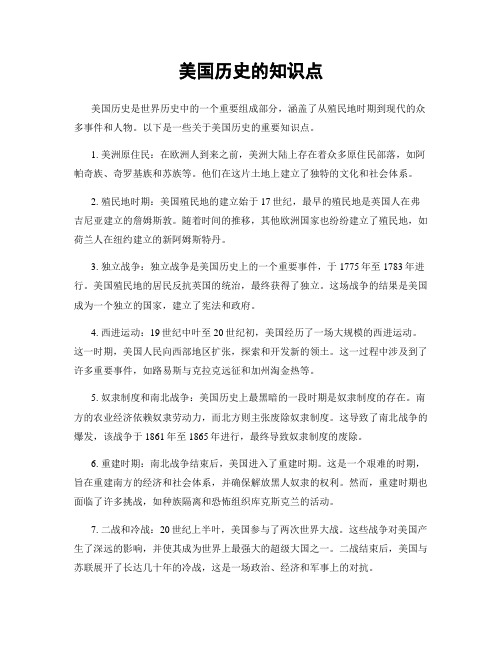
美国历史的知识点美国历史是世界历史中的一个重要组成部分,涵盖了从殖民地时期到现代的众多事件和人物。
以下是一些关于美国历史的重要知识点。
1. 美洲原住民:在欧洲人到来之前,美洲大陆上存在着众多原住民部落,如阿帕奇族、奇罗基族和苏族等。
他们在这片土地上建立了独特的文化和社会体系。
2. 殖民地时期:美国殖民地的建立始于17世纪,最早的殖民地是英国人在弗吉尼亚建立的詹姆斯敦。
随着时间的推移,其他欧洲国家也纷纷建立了殖民地,如荷兰人在纽约建立的新阿姆斯特丹。
3. 独立战争:独立战争是美国历史上的一个重要事件,于1775年至1783年进行。
美国殖民地的居民反抗英国的统治,最终获得了独立。
这场战争的结果是美国成为一个独立的国家,建立了宪法和政府。
4. 西进运动:19世纪中叶至20世纪初,美国经历了一场大规模的西进运动。
这一时期,美国人民向西部地区扩张,探索和开发新的领土。
这一过程中涉及到了许多重要事件,如路易斯与克拉克远征和加州淘金热等。
5. 奴隶制度和南北战争:美国历史上最黑暗的一段时期是奴隶制度的存在。
南方的农业经济依赖奴隶劳动力,而北方则主张废除奴隶制度。
这导致了南北战争的爆发,该战争于1861年至1865年进行,最终导致奴隶制度的废除。
6. 重建时期:南北战争结束后,美国进入了重建时期。
这是一个艰难的时期,旨在重建南方的经济和社会体系,并确保解放黑人奴隶的权利。
然而,重建时期也面临了许多挑战,如种族隔离和恐怖组织库克斯克兰的活动。
7. 二战和冷战:20世纪上半叶,美国参与了两次世界大战。
这些战争对美国产生了深远的影响,并使其成为世界上最强大的超级大国之一。
二战结束后,美国与苏联展开了长达几十年的冷战,这是一场政治、经济和军事上的对抗。
8. 民权运动:20世纪中叶,美国发生了一场重要的社会运动,即民权运动。
这场运动旨在争取黑人和其他少数族裔的平等权利,包括废除种族隔离和确保选举权。
著名的领导人如马丁·路德·金和罗莎·帕克斯等人在这场运动中扮演了重要角色。
【推荐下载】高二历史上册第二章美国的建立知识点
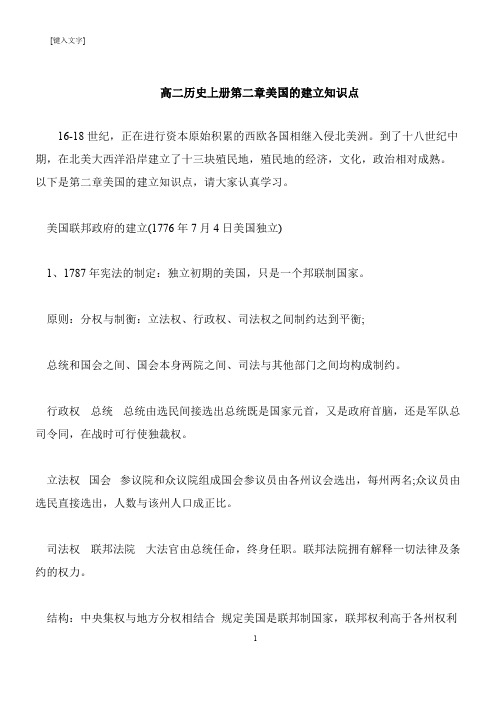
高二历史上册第二章美国的建立知识点16-18世纪,正在进行资本原始积累的西欧各国相继入侵北美洲。
到了十八世纪中期,在北美大西洋沿岸建立了十三块殖民地,殖民地的经济,文化,政治相对成熟。
以下是第二章美国的建立知识点,请大家认真学习。
美国联邦政府的建立(1776年7月4日美国独立) 1、1787年宪法的制定:独立初期的美国,只是一个邦联制国家。
原则:分权与制衡:立法权、行政权、司法权之间制约达到平衡; 总统和国会之间、国会本身两院之间、司法与其他部门之间均构成制约。
行政权总统总统由选民间接选出总统既是国家元首,又是政府首脑,还是军队总司令同,在战时可行使独裁权。
立法权国会参议院和众议院组成国会参议员由各州议会选出,每州两名;众议员由选民直接选出,人数与该州人口成正比。
司法权联邦法院大法官由总统任命,终身任职。
联邦法院拥有解释一切法律及条约的权力。
结构:中央集权与地方分权相结合规定美国是联邦制国家,联邦权利高于各州权利 分割中央权利: 1.立法权国会 2.行政权总统 3.司法权联邦法院 2、1787年宪法的意义: 1.它是世界上第一步比较完整的资产阶级成文宪法(性质),奠定了美国政治制度的基础,促进了美国资本主义的发展; 2.是美国建立起联邦制国家; 3.进一步巩固了独立战争的成果,使美国革命得以完成,维护了美国的统一。
3、1787年宪法的局限性:反映人民群众权益的《权利法案》是几年后作为修正案补充进宪法的; 它承认黑人奴隶制和黑奴贸易,留下种族歧视和压迫的烙印; 妇女、印第安人、黑人奴隶的选举权被剥夺。
第二章美国的建立知识点的全部内容就是这些,希望通过本文对大家有所帮助。
相关链接 高二历史上册第二章法国大革命和拿破仑帝国知识点 高二历史上册第二章欧洲的启蒙运动知识点。
SAT2 美国历史总结
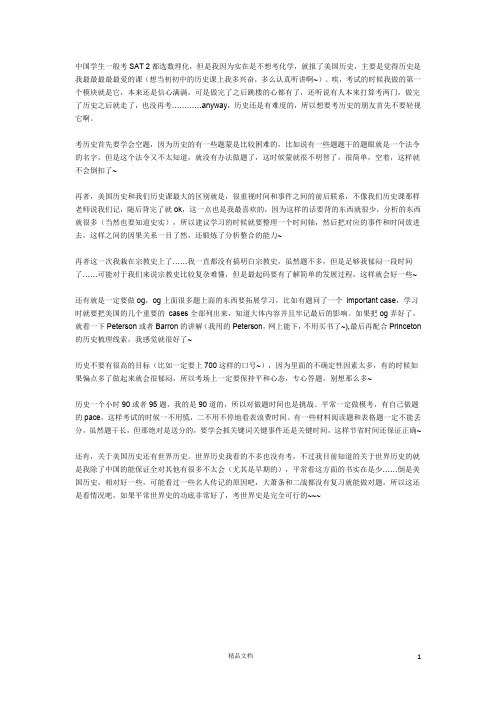
中国学生一般考SAT 2都选数理化,但是我因为实在是不想考化学,就报了美国历史,主要是觉得历史是我最最最最最爱的课(想当初初中的历史课上我多兴奋,多么认真听讲啊~)。
唉,考试的时候我做的第一个模块就是它,本来还是信心满满,可是做完了之后跳楼的心都有了,还听说有人本来打算考两门,做完了历史之后就走了,也没再考…………anyway,历史还是有难度的,所以想要考历史的朋友首先不要轻视它啊。
考历史首先要学会空题,因为历史的有一些题蒙是比较困难的,比如说有一些题题干的题眼就是一个法令的名字,但是这个法令又不太知道,就没有办法做题了,这时候蒙就很不明智了,很简单,空着,这样就不会倒扣了~再者,美国历史和我们历史课最大的区别就是,很重视时间和事件之间的前后联系,不像我们历史课那样老师说我们记,随后背完了就ok,这一点也是我最喜欢的,因为这样的话要背的东西就很少,分析的东西就很多(当然也要知道史实),所以建议学习的时候就要整理一个时间轴,然后把对应的事件和时间放进去,这样之间的因果关系一目了然,还锻炼了分析整合的能力~再者这一次我栽在宗教史上了……我一直都没有搞明白宗教史,虽然题不多,但是足够我郁闷一段时间了……可能对于我们来说宗教史比较复杂难懂,但是最起码要有了解简单的发展过程,这样就会好一些~还有就是一定要做og,og上面很多题上面的东西要拓展学习,比如有题问了一个important case,学习时就要把美国的几个重要的cases全部列出来,知道大体内容并且牢记最后的影响。
如果把og弄好了,就看一下Peterson或者Barron的讲解(我用的Peterson,网上能下,不用买书了~),最后再配合Princeton 的历史梳理线索,我感觉就很好了~历史不要有很高的目标(比如一定要上700这样的口号~),因为里面的不确定性因素太多,有的时候如果偏点多了做起来就会很郁闷,所以考场上一定要保持平和心态,专心答题,别想那么多~历史一个小时90或者95题,我的是90道的,所以对做题时间也是挑战。
美国高中历史知识点总结完整版
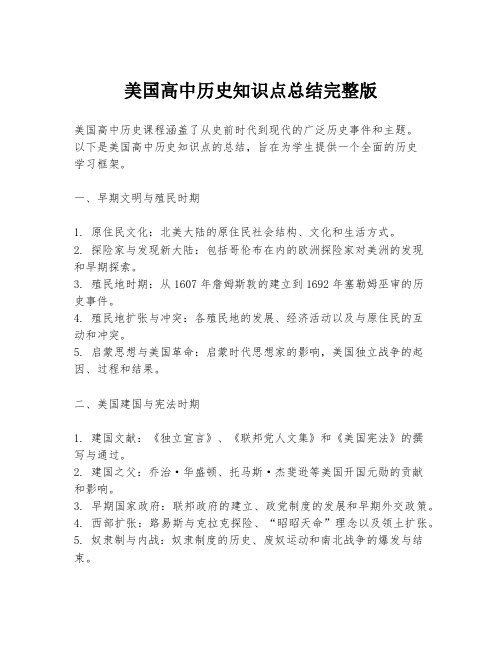
美国高中历史知识点总结完整版美国高中历史课程涵盖了从史前时代到现代的广泛历史事件和主题。
以下是美国高中历史知识点的总结,旨在为学生提供一个全面的历史学习框架。
一、早期文明与殖民时期1. 原住民文化:北美大陆的原住民社会结构、文化和生活方式。
2. 探险家与发现新大陆:包括哥伦布在内的欧洲探险家对美洲的发现和早期探索。
3. 殖民地时期:从1607年詹姆斯敦的建立到1692年塞勒姆巫审的历史事件。
4. 殖民地扩张与冲突:各殖民地的发展、经济活动以及与原住民的互动和冲突。
5. 启蒙思想与美国革命:启蒙时代思想家的影响,美国独立战争的起因、过程和结果。
二、美国建国与宪法时期1. 建国文献:《独立宣言》、《联邦党人文集》和《美国宪法》的撰写与通过。
2. 建国之父:乔治·华盛顿、托马斯·杰斐逊等美国开国元勋的贡献和影响。
3. 早期国家政府:联邦政府的建立、政党制度的发展和早期外交政策。
4. 西部扩张:路易斯与克拉克探险、“昭昭天命”理念以及领土扩张。
5. 奴隶制与内战:奴隶制度的历史、废奴运动和南北战争的爆发与结束。
三、工业化与改革时期1. 工业革命:19世纪的工业发展、城市化和社会变革。
2. 移民潮:19世纪末至20世纪初的大规模移民潮及其对美国社会的影响。
3. 改革运动:妇女参政权运动、进步时代改革和社会立法。
4. 经济大萧条:1929年股市崩盘、大萧条的原因、影响和新政。
5. 第二次世界大战:美国参战的原因、战争进程和战后世界秩序的重建。
四、冷战与民权时期1. 冷战的起源:二战后美苏关系的转变、冷战的开始和核武器竞赛。
2. 民权运动:非裔美国人争取平等权利的斗争、马丁·路德·金等人的贡献。
3. 越南战争:美国介入越南战争的原因、过程和反战运动。
4. 冷战政策:遏制政策、马歇尔计划和冷战期间的美苏对抗。
5. 冷战结束:苏联解体、冷战结束和后冷战时代的国际关系。
五、当代美国与全球问题1. 信息时代:计算机和互联网的发展、全球化和经济变化。
- 1、下载文档前请自行甄别文档内容的完整性,平台不提供额外的编辑、内容补充、找答案等附加服务。
- 2、"仅部分预览"的文档,不可在线预览部分如存在完整性等问题,可反馈申请退款(可完整预览的文档不适用该条件!)。
- 3、如文档侵犯您的权益,请联系客服反馈,我们会尽快为您处理(人工客服工作时间:9:00-18:30)。
SAT2美国历史重点知识总结
SAT2世界历史是很多同学们比较感兴趣的科目,尤其大家对SAT2美国历史有很深的见解。
下面小编就给大家重点总结一下SAT2美国历史中的一些重要内容。
希望对大家有所帮助。
殖民地时期
* 1607—第一批英国移民来到Jameston
* 1620 —Pilgrims和《Mayfloer Compact》
* 殖民地的生活概述:政治、经济、宗教
* Roger illiams和Anne Hutchinson
* 大觉醒运动(The First Great Aakening)
* virtual representation
* 英法七年战争(French and Indian ar)
* 一系列增税法案(SuguarAct,StampAct,Tonshend Acts)
* 波士顿倾茶事件(Boston Tea Party)
约翰-洛克与托马斯-潘恩的影响(John Locke & Thomas Paine)
独立宣言(Declaration of Independence)
法国参战与战争的结束
《邦联条例》(Articles of Confederation)
谢斯起义(Shay's Rebellion)
宪法(Constitution)的诞生
《联邦党人文集》(Federalist Papers)
《权利法案》(Bill of Rights)
杰弗逊与汉米尔顿(Jefferson VS Hamilton)
XYZ事件(XYZ Affair)
西进运动(上)
Luis and Clark的远征
Louisiana Purchase
最高法院树立权威(Marbury v. Madison)
禁运法(Embargo Act, 1807)
1812年战争
Missouri Compromise
门罗主义( Monroe Doctrine)
1824年选举
Indian Removal Act of 1830
西进运动(下)
* 废止危机(Nullification Crisis)1832
* the Second Great Aakening和Social Reform
* the American Renaissance (Emerson, Thoreau, hitman, Melville, Hathorne)
Stanton&Anthony
天定命运(Manifest Destiny)
南北战争前后
美墨之战(The Mexican ar)
国会三巨头
The Compromise of 1850
SAT2美国历史也是同学们比较容易复习的科目,文科生一般都会先泽SAT2世界历史,因为这方面比较擅长吗,建议一些基础较弱的同学参加一下SAT2培训班来帮助自己备考SAT2考试。
* 矛盾的激化(John Bron, underground railroad)
内战爆发
* 罗伯特-李和格兰特将军(Robert Lee VS Grant)
盖底斯堡
重建时期(Reconstruction)
* 弹劾约翰逊(impeachment of Andre Johnson)
镀金时代
太平洋铁路的建成和石油的开发使用
* Battle of Little Big Horn (Crazyhorse VS Custer)
排华法案
伟大的发明家们
* 垄断资本与工会的兴起进步主义时代( Progressive Era )
门户开放政策(Open Door Policy)
* 美西战争
二十世纪上半叶
罗斯福王
社会主义运动
第一次世界大战
理想主义者威尔逊
妇女获得选举权
史上最烂总统
汽车王国与爵士时代
失落的一代与二十年代文学的发展
经济大萧条(Great Depression)
罗斯福新政(Ne Deal)
第二次世界大战
珍珠港
血战太平洋
冷战初期
* 冷战(Cold ar)的开始与马歇尔计划(Marshall Plan) 杜鲁门与1948年选举
朝鲜战争(Korean ar)
麦卡锡主义
电视的普及与高速公路的建设
* 肯尼迪与新边疆政策(JFK & Ne Frontier)
古巴导弹危机
六十年代至今
小石城事件
Gidon VS ainright
妇女解放与环保主义运动
越战升级
林登-约翰逊与伟大社会计划( Great Society) 六十年代的民权运动
中美建交
水门事件(atergateScandle)
里根与星球大战计划
冷战大结局---美国不战而胜
信息时代的来临。
